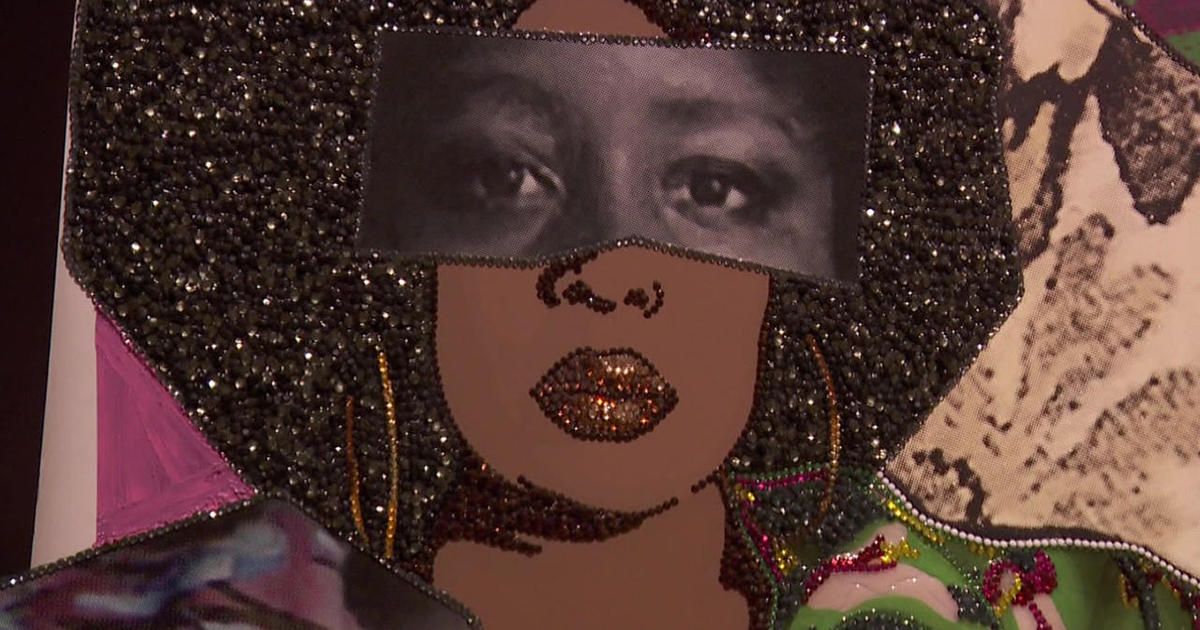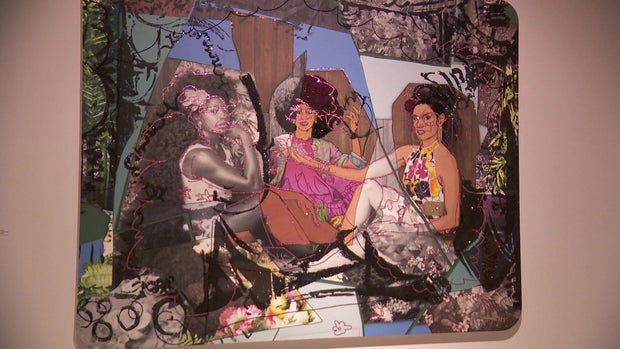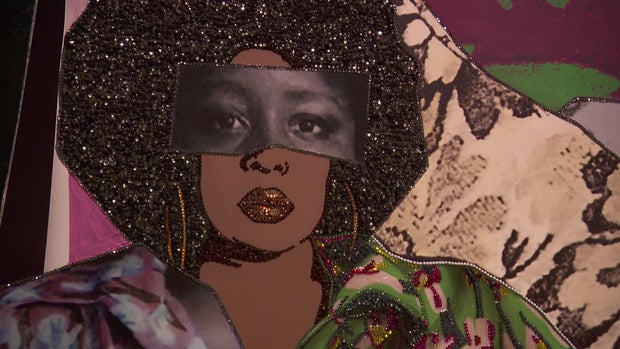When you walk into the world of Mickalene Thomas, prepare to be dazzled. The 53-year-old artist uses rhinestones, collage, silkscreen and video to create pieces that celebrate women – proud, confident and powerful.
She may be best known for her reinterpretations of classics, like her “Le déjeuner sur l’herbe,” a take on the Pablo Picasso and Edouard Manet paintings of the same name. “Our histories are always wrought with ideas of leaving truths out, leaving people out,” said Thomas. “And so, I started questioning that.”
CBS News
Thomas shifted the focus to women she finds beautiful. Her muses are sometimes famous, more often not: “The everyday Black woman who should be celebrated; the women who are on the street, the women who are the laborers, the workers, but still exude this excellence of self-awareness and pride, and vulnerability and strength at the same time.”
Like all great artists, she has an understanding, a grasp of what great historical artists are doing, and she’s saying, ‘Okay, I’m gonna turn that around, I’m going to make that my own,'” said Joanne Heyler, founding director of the Broad Museum in Los Angeles, home to the exhibition, “Mickalene Thomas: All About Love.” “She is completely changing who’s centered in traditional Western (especially European) painting. And she’s centering Black women, she’s centering queer women and queer identity, and she’s doing that with these beautiful works with glitter and rhinestone, literally bringing light and illumination to those lives.”
Mickalene Thomas
The exhibit starts with a life-sized recreation of the Camden, New Jersey row houses where Thomas grew up.
Early on, she knew she wanted to make a difference, so in college she studied pre-law. “Why not think about being a lawyer, and changing some necessary laws in this country?” she laughed.
She said that “changing the world” was the goal. That is, until the day she visited a museum and saw the “Kitchen Table Series,” a set of photographs by renowned artist Carrie Mae Weems. “In that moment, when I saw those photographs at the museum, I knew I wanted to be an artist,” said Thomas. “That was it. That’s what art is supposed to do. It’s supposed to move you. incite you. And if we don’t see ourselves in images, we don’t know what’s possible.”
Smith asked, “So, you knew you wanted to do art. Did you know you could make a living at that point?”
“You’re funny!” laughed Thomas. “No!”
In fact, her mixing of media came, at least in part, out of necessity, like her signature rhinestones, which are put on one by one and can number into the thousands on just one piece. “Oil paint is very expensive,” Thomas said. “So, I used what was around me, what was accessible, what was affordable. And sometimes that was materials that other people threw away: ‘Well, okay, I can’t afford paint. But I’m gonna work with these things.’
“A lot of my process comes out of limitations. But my life has always been about limitations and working within that, around it, and through it, and above it.”
CBS News
“Above it” is right; her work is now in museums all over the world.
And just this past May, when she was honored by the Gordon Parks Foundation in New York, Thomas’ journey came full circle. Presenting her award was Carrie Mae Weems, the artist whose work had inspired her to change her life’s path 30 years ago.
Mickalene Thomas didn’t become a lawyer, but that dream of making a difference still came true. “To have an idea, and to take that idea, to transmit it through yourself, to make it come to fruition, and to make something that the world or a group of people respond to, now that’s life, right?” Thomas said. “That’s changing the world.”
For more info:
Story produced by Julie Kracov. Editor: Steven Tyler.
See also:



